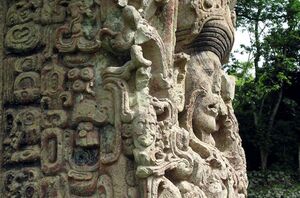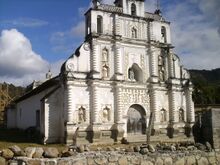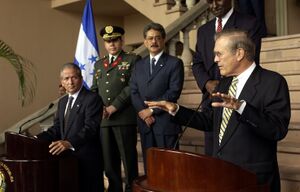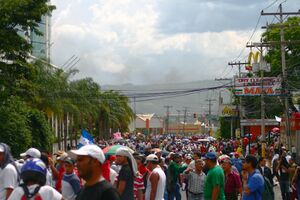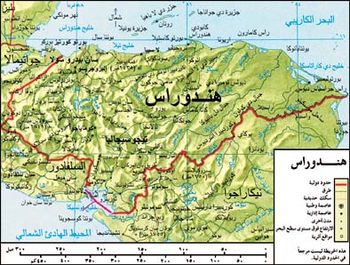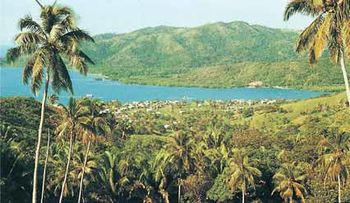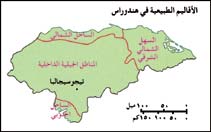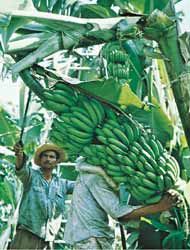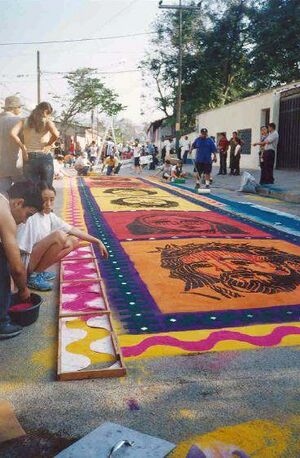هندوراس
جمهورية هندوراس República de Honduras (إسپانية) | |
|---|---|
الشعار الحادي: Libre, Soberana e Independiente "Free, Sovereign and Independent" | |
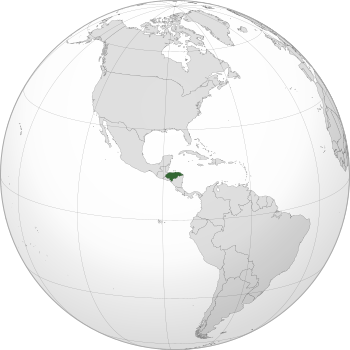 | |
| العاصمة و أكبر مدينة | تگوسيگالپا 14°6′N 87°13′W / 14.100°N 87.217°W |
| اللغات الرسمية | Spanish |
| الجماعات العرقية (2016)[1] | |
| الدين (2020)[2] |
|
| صفة المواطن |
|
| الحكومة | Unitary presidential republic |
• الرئيسة | سيومارا كاسترو |
| سلڤادور نصر الله Doris Gutiérrez Renato Florentino | |
| Luis Redondo | |
| التشريع | National Congress |
| الاستقلال | |
• Declaredb عن إسپانيا | 15 سبتمبر 1821 |
• Declared from the الإمبراطورية المكسيكية الأولى | 1 يوليو 1823 |
• Declared, as Honduras, from the Federal Republic of Central America | 5 نوفمبر 1838 |
| المساحة | |
• الإجمالية | 112,492 km2 (43,433 sq mi) (101st) |
| التعداد | |
• تقدير 2023 | 9,571,352[3] (95th) |
• الكثافة | 85/km2 (220.1/sq mi) (128) |
| ن.م.إ. (ق.ش.م.) | تقدير 2023 |
• الإجمالي | ▲ $75.030 billion[4] (108th) |
• للفرد | ▲ $7,162[4] (134th) |
| ن.م.إ. (الإسمي) | تقدير 2023 |
• الإجمالي | ▲ $33.992 billion[4] (106th) |
• للفرد | ▲ $3,245[4] (135th) |
| جيني (2018) | ▲ 52.1[5] high |
| م.ت.ب. (2021) | medium · 137th |
| العملة | Lempira (HNL) |
| التوقيت | UTC−6 (CST) |
| جانب السواقة | right |
| مفتاح الهاتف | +504 |
| النطاق العلوي للإنترنت | .hn |
| |
Population estimates explicitly take into account the effects of excess mortality due to AIDS; this can result in lower life expectancy, higher infant mortality and death rates, lower population and growth rates, and changes in the distribution of population by age and sex than would otherwise be expected, as of July 2007. | |
هندوراس Honduras،[أ] officially the Republic of Honduras,[ب] هي دولة من دول أمريكا الوسطى، يحدها من الشمال البحر الكاريبي، ومن الشمال الغربي دولة غواتيمالا، ومن الجنوب الغربي السلفادور، ومن الجنوب نيكاراجوا والمحيط الهادئ. هُندوراس دولة صغيرة في أمريكا الوسطى تشتهر بإنتاج الموز. وهي دولة فقيرة ينخفض فيها معدل دخل السكان، ويعمل أكثر من نصف السكان في الزراعة. وتبلغ نسبة العاطلين فيها ربع عدد سكانها تقريباً، ويُعد الموز مصدر الدخل الرئيسي في البلاد. ويقوم عدد كبير من السكان بزراعته في الأراضي المنخفضة الشمالية على امتداد البحر الكاريبي.
ويربي كثيرٌ من الناس الأبقار في الجبال الداخلية، ويزرعونالفاصوليا والبن والذرة الشامية. و تيجوسيجالبا هي العاصمة وكبرى المدن في البلاد، وتقع في منطقة الجبال الداخلية. أما وسائل النقل في البلاد فهي محدودة. وتعتبر تيجوسيجالبا من العواصم القليلة التي تخلو من السكك الحديدية. ويُربِّي كثير من الهندوراسيين الماشية ويزرعون القطن في السهول المتاخمة للمحيط الهادي، في الجزء الجنوبي من البلاد. وصل كريستوفر كولمبوس إلى هندوراس عام 1502م. وربما كان كولمبوس أو أحد المكتشفين الذين جاءوا بعده هو الذي أعطاها هذا الاسم. وكلمة هندوراس كلمة أسبانية تعني الأعماق، بسبب عمق المياه في البحر الكاريبي بعيداً عن الساحل الشمالي.
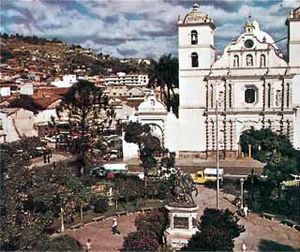 تيغوسيغالپا عاصمة هندوراس، تقع في منطقة مرتفعة بين الجبال الوسطى في البلاد. |
. . . . . . . . . . . . . . . . . . . . . . . . . . . . . . . . . . . . . . . . . . . . . . . . . . . . . . . . . . . . . . . . . . . . . . . . . . . . . . . . . . . . . . . . . . . . . . . . . . . . . . . . . . . . . . . . . . . . . . . . . . . . . . . . . . . . . . . . . . . . . . . . . . . . . . . . . . . . . . . . . . . . . . . .
أصل الاسم
The literal meaning of the term "Honduras" is "depths" in Spanish. The name could either refer to the bay of Trujillo as an anchorage, fondura in the Leonese dialect of Spain, or to Columbus's alleged quote that "Gracias a Dios que hemos salido de esas honduras" ("Thank God we have departed from those depths").[8][9][10]
It was not until the end of the 16th century that Honduras was used for the whole province. Prior to 1580, Honduras referred to only the eastern part of the province, and Higueras referred to the western part.[10] Another early name is Guaymuras, revived as the name for the political dialogue in 2009 that took place in Honduras as opposed to Costa Rica.[11]
Hondurans are often referred to as Catracho or Catracha (fem) in Spanish.
التاريخ
فترة ما قبل الاستعمار
In the pre-Columbian era, modern Honduras was split between two pan-cultural regions: Mesoamerica in the west and the Isthmo-Colombian area in the east. Each complex had a "core area" within Honduras (the Sula Valley for Mesoamerica, and La Mosquitia for the Isthmo-Colombian area), and the intervening area was one of gradual transition. However, these concepts had no meaning in the Pre-Columbian era itself and represent extremely diverse areas. The Lenca people of the interior highlands are also generally considered to be culturally Mesoamerican, though the extent of linkage with other areas varied over time (for example, expanding during the zenith of the Toltec Empire).
In the extreme west, Maya civilization flourished for hundreds of years. The dominant, best known, and best studied state within Honduras's borders was in Copán, which was located in a mainly non-Maya area, or on the frontier between Maya and non-Maya areas. Copán declined with other Lowland centres during the conflagrations of the Terminal Classic in the 9th century. The Maya of this civilization survive in western Honduras as the Ch'orti', isolated from their Choltian linguistic peers to the west.[12]
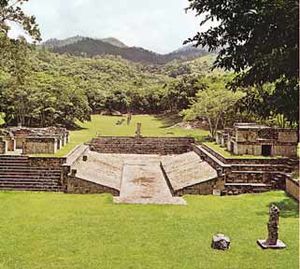 ملعب للهنود المايا ما نزال نراه الآن بمدينة كوبان، وهي مركز قديم للحضارة. وكان المايا يلعبون لعبة تشبه كرة القدم. |
However, Copán represents only a fraction of Honduran pre-Columbian history. Remnants of other civilizations are found throughout the country. Archaeologists have studied sites such as Naco and La Sierra in the Naco Valley, Los Naranjos on Lake Yojoa, Yarumela in the Comayagua Valley,[13] La Ceiba and Salitron Viejo[14] (both now under the Cajón Dam reservoir), Selin Farm and Cuyamel in the Aguan valley, Cerro Palenque, Travesia, Curruste, Ticamaya, Despoloncal, and Playa de los Muertos in the lower Ulúa River valley, and many others.
In 2012, LiDAR scanning revealed that several previously unknown high density settlements existed in La Mosquitia, corresponding to the legend of "La Ciudad Blanca". Excavation and study has since improved knowledge of the region's history. It is estimated that these settlements reached their zenith from 500 to 1000 AD.
لا يُعرف إلا القليل عما يُطلق عليه الآن هندوراس قبل وصول الأسبان في أوائل القرن السادس عشر الميلادي. وقد ازدهر في كوبان مركز شرقي لحضارة المايا الهندية الشهيرة حتى القرن التاسع الميلادي. وكان بكوبان القصور المبنية من الحجارة الجميلة والأهرام والمعابد، وكان سكانها متقدمين في العلوم والتعليم. ولكن مع وصول الأسبان تعرضت كوبان للخراب ونسي هنود المنطقة هذه المدينة .
الفترة الاستعمارية (1524-1539)
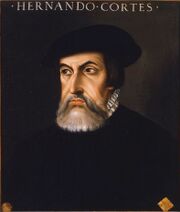
في عام 1502 نزل كريستوفر كولمبوس في كاپو دى هندوراس (رأس هندوراس). وقد ضم الأرض لأسبانيا. ثم زار المنطقة عدد من المكتشفين الأسبان وأسسوا المستعمرات فيها. وتلقى الهنود الهزيمة تدريجياً على يد الأسبان، حيث قُتل كثيرٌ منهم أو ماتوا بسبب الأمراض أو نقلوا بالسفن كمستعبدين للعمل في المزارع في جزر الهند الغربية.
On his fourth and the final voyage to the New World in 1502, Christopher Columbus landed near the modern town of Trujillo, near Guaimoreto Lagoon, becoming the first European to visit the Bay Islands on the coast of Honduras.[15] On 30 July 1502, Columbus sent his brother Bartholomew to explore the islands and Bartholomew encountered a Mayan trading vessel from Yucatán, carrying well-dressed Maya and a rich cargo.[16][17] Bartholomew's men stole the cargo they wanted and kidnapped the ship's elderly captain to serve as an interpreter[17] in the first recorded encounter between the Spanish and the Maya.[18]
In March 1524, Gil González Dávila became the first Spaniard to enter Honduras as a conquistador.[19][20] followed by Hernán Cortés, who had brought forces down from Mexico. Much of the conquest took place in the following two decades, first by groups loyal to Cristóbal de Olid, and then by those loyal to Francisco de Montejo but most particularly by those following Alvarado.[من؟] In addition to Spanish resources, the conquerors relied heavily on armed forces from Mexico—Tlaxcalans and Mexica armies of thousands who remained garrisoned in the region.
Resistance to conquest was led in particular by Lempira. Many regions in the north of Honduras never fell to the Spanish, notably the Miskito Kingdom. After the Spanish conquest, Honduras became part of Spain's vast empire in the New World within the Kingdom of Guatemala. Trujillo and Gracias were the first city-capitals. The Spanish ruled the region for approximately three centuries.
طوّر الأسبان مناجم الذهب والفضة في هندوراس، وأحضروا كثيرًا من الرقيق من إفريقيا للعمل بالمناجم مع الهنود. وطوروا كذلك مزارع الأبقار لكي تقوم بتزويد مراكز التعدين بالغذاء اللازم. ولكن هذه المناجم لم تكن مربحة لدرجة تكفي لجذب الكثير من المستعمرين.
هندوراس الإسپانية (1524–1821)
Honduras was organized as a province of the Kingdom of Guatemala and the capital was fixed, first at Trujillo on the Atlantic coast, and later at Comayagua, and finally at Tegucigalpa in the central part of the country.
Silver mining was a key factor in the Spanish conquest and settlement of Honduras.[21] Initially the mines were worked by local people through the encomienda system, but as disease and resistance made this option less available, slaves from other parts of Central America were brought in. When local slave trading stopped at the end of the sixteenth century, African slaves, mostly from Angola, were imported.[22] After about 1650, very few slaves or other outside workers arrived in Honduras.
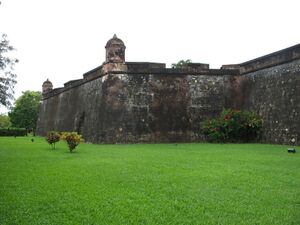
Although the Spanish conquered the southern or Pacific portion of Honduras fairly quickly, they were less successful on the northern, or Atlantic side. They managed to found a few towns along the coast, at Puerto Caballos and Trujillo in particular, but failed to conquer the eastern portion of the region and many pockets of independent indigenous people as well. The Miskito Kingdom in the northeast was particularly effective at resisting conquest. The Miskito Kingdom found support from northern European privateers, pirates and especially the British formerly English colony of Jamaica, which placed much of the area under its protection after 1740.
الاستقلال (1821)
وفي عام 1821م أعلنت هندوراس وأربع دول في أمريكا الوسطى استقلالها عن أسبانيا وأصبحت جزءاً من الإمبراطورية المكسيكية. ولكن هذه الدول انشقت عنها عام 1823م وكونت المقاطعات المتحدة لأمريكا الوسطى. وقد اتّبع هذا الاتحاد سياسات حرة، وأقر بعض الحقوق المدنية وأنهى الامتيازات الخاصة بطبقة النبلاء القوية، وامتيازات الكنيسة الكاثوليكية الرومانية. تركت هندوراس الاتحاد عام 1838 بعد أن بدأ الاتحاد في التفكك تحت ضغوط مختلفة من بينها محاولات أصحاب الأراضي ورجال الدين استعادة امتيازاتهم.
كانت هندوراس أضعف بلاد أمريكا الوسطى جميعاً، مما جعلها تصبح تحت نفوذ جيرانها الأقوياء، وخصوصاً جواتيمالا. وفي القرن التاسع عشر ساعدت على نشوب عدد من الثورات في هندوراس، حيث دعّمت المحافظين أو الليبراليين الهندوراسيين، على حسب وجود هؤلاء في السلطة في جواتيمالا نفسها. بدأت شركات الفاكهة الأمريكية في الوصول إلى هندوراس في التسعينيات من القرن التاسع عشر لزراعة الموز فيها. وقد أزالت هذه الشركات الغابات وجففت المستنقعات للزارعة في منطقة الساحل الشمالي ، وبنت السكك الحديدية والموانئ. كما أسست المدن والمستشفيات والمدارس للعمال. وفي بداية القرن العشرين أصبح الموز أهم مصدر للدخل في هندوراس. وكانت ضرائب التصدير التي تدفعها شركات الفاكهة الأمريكية تفي بمعظم نفقات حكومة هندوراس. وقد أعطت الحكومة للشركات امتيازات خاصة من أجل زيادة هذا الدخل، فصار لهذه الشركات تأثير قوي على الحكومة. أطلق تعبير جمهوريات الموز على كثير من بلدان أمريكا اللاتينية، وأول بلدٍ أطلق عليه هذا الاسم هندوراس.
Policies favoring international trade and investment began in the 1870s, and soon foreign interests became involved, first in shipping from the north coast, especially tropical fruit and most notably bananas, and then in building railroads. In 1888, a projected railroad line from the Caribbean coast to the capital, Tegucigalpa, ran out of money when it reached San Pedro Sula. As a result, San Pedro grew into the nation's primary industrial center and second-largest city. Comayagua was the capital of Honduras until 1880, when the capital moved to Tegucigalpa.
Since independence, nearly 300 small internal rebellions and civil wars have occurred in the country, including some changes of régime.[23][24]
. . . . . . . . . . . . . . . . . . . . . . . . . . . . . . . . . . . . . . . . . . . . . . . . . . . . . . . . . . . . . . . . . . . . . . . . . . . . . . . . . . . . . . . . . . . . . . . . . . . . . . . . . . . . . . . . . . . . . . . . . . . . . . . . . . . . . . . . . . . . . . . . . . . . . . . . . . . . . . . . . . . . . . . .
القرن العشرون ودور الشركات الأمريكية
In the late nineteenth century, Honduras granted land and substantial exemptions to several US-based fruit and infrastructure companies in return for developing the country's northern regions. Thousands of workers came to the north coast as a result to work in banana plantations and other businesses that grew up around the export industry. Banana-exporting companies, dominated until 1930 by the Cuyamel Fruit Company, as well as the United Fruit Company, and Standard Fruit Company, built an enclave economy in northern Honduras, controlling infrastructure and creating self-sufficient, tax-exempt sectors that contributed relatively little to economic growth. American troops landed in Honduras in 1903, 1907, 1911, 1912, 1919, 1924 and 1925.[25]
In 1904, the writer O. Henry coined the term "banana republic" to describe Honduras,[26] publishing a book called Cabbages and Kings, about a fictional country, Anchuria, inspired by his experiences in Honduras, where he had lived for six months.[27] In The Admiral, O.Henry refers to the nation as a "small maritime banana republic"; naturally, the fruit was the entire basis of its economy.[28][29] According to a literary analyst writing for The Economist, "his phrase neatly conjures up the image of a tropical, agrarian country. But its real meaning is sharper: it refers to the fruit companies from the United States that came to exert extraordinary influence over the politics of Honduras and its neighbors."[30][31] In addition to drawing Central American workers north, the fruit companies encouraged immigration of workers from the English-speaking Caribbean, notably Jamaica and Belize, which introduced an African-descended, English-speaking and largely Protestant population into the country, although many of these workers left following changes to immigration law in 1939.[32] Honduras joined the Allied Nations after Pearl Harbor, on 8 December 1941, and signed the Declaration by United Nations on 1 January 1942, along with twenty-five other governments.
الحرب والاضطرابات
لم يكن الرؤساء الهندوراسيّون حتي عام 1933 يدومون طويلاً بسبب الانقلابات العسكرية الكثيرة. إلا أن الجنرال تبورسيو كارياس أندينو أصبح رئيساً عام 1933، وبقي في الرئاسة أطول مدة وهي 16 سنة. وكان كارياس مستبداً، فشلت عدة محاولات في الإطاحة به ولكنه تقاعد عام 1948م. وأدت أعمال العنف السياسي خلال الخمسينيات من القرن العشرين إلى انتخاب رامون فيليدا موراليس وهو طبيب، ليصبح رئيساً عام 1957م. وقد أنشأ فيليدا برنامجاً لإصلاح الأراضي وبنى المستشفيات والطرق والمدارس. وفي عام 1963م أطاحت بالحكومة حركة عسكرية قادها العقيد أوسفالدو لوبيز أريلانو. وقامت جمعية تم انتخابها بإعداد دستور جديد مكّن لوبيز من أن يصبح رئيساً. وفي عام 1971 انتُخب إرنستو كروز وهو محام، رئيساً للبلاد. ولكن القوات المسلحة أطاحت بحكومة كروز، وأعادت لوبيز إلى السلطة مرة أخرى. وفي عام 1969 أجبر قانون هندوراسي للإصلاح الزراعي عدداً كبيراً من العائلات السلفادورية التي تعيش في هندوراس على التخلي عن أراضيها. فدخلت قوات إلسلفادور إلى هندوراس في يوليو 1969 وغادرتها في أغسطس. وفي عام 1970م ساعدت منظمة الدول الأمريكية البلدين على إنشاء منطقة محايدة على امتداد حدودهما. وفي عام 1980 وقّع البلدان اتفاقاً لإنهاء النزاع الحدودي بينهما.
وفي عام 1975 أبعدت القوات المسلحة لوبيز عن السلطة، ووضعت مكانه الكولونيل خوان ألبرتو ميلغار. اتهُّمت حكومة لوبيز بفضيحة تقاضي رشوة من شركة أمريكية لتخفيض ضريبة صادراتها من الموز. وفي عام 1978 أزاح ثلاثة من قادة القوات المسلحة ميلغار عن السلطة واستولوا على الحكومة. وفي عام 1981 أجريت انتخابات لاختيار حكومة مدنية، فاختار الناس روبرتو سوازو كوردوفا رئيسًا للبلاد، كما اختاروا هيئة تشريعية جديدة. وفي عام 1985 تم اختيار خوسيه أزكونا خويو كرئيس بعد سوازو. وفي الثمانينيات من القرن العشرين أصبحت هندوراس حلبة للصراع بين قوات حكومة نيكاراجوا الساندينيستية والثوار النيكاراجويين الذين كانوا يحاولون الإطاحة بالساندينيستيين.
أنشأ الثوار ويدعون الكونترا قواعد لحرب العصابات في هندوراس، وكانوا يهاجمون نيكاراجوا من هذه القواعد. وكانت قوات الساندينيستيين تدخل هندوراس أحيانًا لمهاجمة الكونترا. وفي مارس من عام 1988 وضع الكونترا وحكومة نيكاراجوا الساندينيستية اتفاقية لوقف إطلاق النار بينهما. وفي عام 1989 انتخب رفائيل ليوناردو كاليجاس رئيسًا للبلاد. وفي انتخابات عام 1990، سقطت الحكومة الساندينيستية، ثم أغلقت قواعد الكونترا في هندوراس.
ظل شعب هندراوس منذ عام 1981، ينتخب رئيسًا وبرلمانًا جديدين كل أربع سنوات. وفي عام 1993، انتخب كارلوس روبرتو رينا رئيسًا للبلاد. عمل رينا في فترة رئاسته على المضي قدمًا في إصلاحاته الاقتصادية وتقليص نفوذ الجيش. وفي عام 1997، تم انتخاب كارلوس روبرتو فلورس رئيساً للبلاد، والذي قال أن خمسين عاماً من التقدم في البلد قد ضاعت.
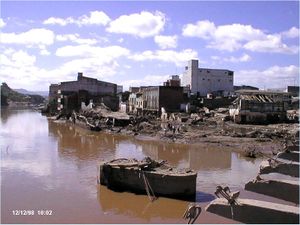
وفي عام 1998، ضرب إعصار ميتش الممطر هندوراس مسبباً فيضانات وانزلاقات أرضية بطول البلاد وعرضها. وقد لقي أكثر من 7,000 مواطن حتفه، ودمر أكثر من 70,000 منزل، وقدرت الخسائر بنحو 3 بليون دولار أمريكي. واتلفت الفيضانات أكثر من نصف محاصيل البلاد، ودمر معظم الجسور والطرقات.[33]
القرن 21
In 2007, President of Honduras Manuel Zelaya and President of the United States George W. Bush began talks on US assistance to Honduras to tackle the latter's growing drug cartels in Mosquito, Eastern Honduras using US special forces. This marked the beginning of a new foothold for the US military's continued presence in Central America.[34]
Under Zelaya, Honduras joined ALBA in 2008, but withdrew in 2010 after the 2009 Honduran coup d'état.[35] In 2009, a constitutional crisis resulted when power was transferred in a coup from the president to the head of Congress. The OAS suspended Honduras because it did not regard its government as legitimate.[36][37]
Countries around the world, the OAS, and the United Nations[38] formally and unanimously condemned the action as a coup d'état, refusing to recognize the de facto government, even though the lawyers consulted by the Library of Congress submitted to the United States Congress an opinion that declared the coup legal.[38][39][40] The Honduran Supreme Court also ruled that the proceedings had been legal. The government that followed the de facto government established a truth and reconciliation commission, Comisión de la Verdad y Reconciliación, which after more than a year of research and debate concluded that the ousting had been a coup d'état, and illegal in the commission's opinion.[41][42][43]
On 28 November 2021, the former first lady Xiomara Castro, leftist presidential candidate of opposition Liberty and Refoundation Party, won 53% of the votes in the presidential election to become the first female president of Honduras, bringing an end to the 12-year reign of the right-wing National Party.[44] She was sworn in on 27 January 2022. Her husband, Manuel Zelaya, held the same office from 2006 until 2009.[45]
In April 2022, former president of Honduras, Juan Orlando Hernández, who served two terms between 2014 and January 2022, was extradited to the United States to face charges of drug trafficking and money laundering. Hernandez denied the accusations.[46]
نظام الحكم
أُقرّ دستور هندوراس عام 1982م. وبموجب هذا الدستور يختار الناس الرئيس ليتولى رئاسة الحكومة، وهيئة تشريعية لتتولى وضع قوانين البلاد. ويقوم الرئيس بتعيين مجلس الوزراء. ويرأس أعضاء هذا المجلس الإدارات التي تقوم بتنفيذ أعمال الحكومة. وللعسكريين تأثير كبير على حكومة هندوراس. فحكام البلاد العسكريون مثلاً مسؤولون تماماً عن سياسات الأمن الوطني. ويستطيعون رفض أية تعيينات للرئيس بمجلس الوزراء. وكثيراً ما سيطر القادة العسكريون في هندوراس سيطرة تامة على الحكومة.
انظر إلى النبذة التاريخية في هذه المقالة لمعرفة تفاصيل الدور العسكري في حكومة هندوراس.
السكان
أكثر من 90% من الهندوراسيين من المولدين (من سلالات أسبانية وهندية أمريكية). ويتكلم جميع المولدين تقريبًا اللغة الأسبانية وهم من الرومان الكاثوليك. ويتكلم كثير من السكان اللغة الإنجليزية في الموانئ والمناطق الشمالية التي يُزرع فيها الموز. وقد تعلموا هذه اللغة من شركات الفاكهة الأمريكية التي كانت تعمل هناك.
الأعراق
Ethnic groups in Honduras %[47]
يعيش حوالي 70,000 من المسكيتو الهنود في شمال شرقي هندوراس. وهذه المجموعة مزيج من الهنود الأصليين والعبيد السود المُحرّرين ومجموعات أخرى. وهم يتكلمون لغة المسكيتو. وجميعهم نصارى ينتمي أكثرهم للكنيسة الموريفية، وهي طائفة بروتستانتية. يعيش الغاريفونا أو الكاريب السود على امتداد الساحل الشمالي الغربي لهندوراس ويبلغ عددهم نحو 80,000 نسمة. وينحدر هؤلاء السكان من الأفارقة السود (الرقيق) وهنود الأرواك الأمريكيين في جزيرة البحر الكاريبي المُسماة سانت فينسنت. وفي عام 1797م نقل حكام فينسنت البريطانيون سكان الجزيرة الأوائل إلى هندوراس لأنهم اعتبروا من الثوار. ويتكلم الغاريفونا لغة الأرواك، ولكن معظمهم يتكلم أيضاً اللغة الأسبانية أو الإنجليزية أو اللغتين معاً.
وينتمي معظم سكان جزر باي، التي تقع بعيداً عن الساحل الشمالي، إلى طائفة البروتستانت الذين يتكلمون اللغة الإنجليزية. ويشمل هؤلاء السكان أولئك المنحدرين من غاريفونا، ومن المزارعين الإنجليز، ومن السود المُحررين الذين هاجروا من جزر كيمن في البحر الكاريبي في القرن الثامن عشر.
يعيش حوالي 56% من سكان هندوراس في مناطق ريفية. وتتمتع هندوراس من بين جميع بُلدان نصف الكرة الغربي، بأعلى نسبة من السكان الريفيين، معظمهم فلاحون فقراء يمتلكون أو يستأجرون مزارع صغيرة. ووسائل النقل والمواصلات لدى هؤلاء السكان فقيرة، وهم معزولون عن حياة المدن. وتتم أعمال التطوير في المدن بسبب التوسع في الصناعة والتعليم. ولكن هذه الأعمال لا تصل سكان المزارع إلا ببطء. ويعيش معظم الهندوراسيين الريفيين في بيوت صغيرة من الطوب المصنوع من الطين أو الألواح الخشبية أو الأعمدة أو من الطين، أو من الحجارة.
. . . . . . . . . . . . . . . . . . . . . . . . . . . . . . . . . . . . . . . . . . . . . . . . . . . . . . . . . . . . . . . . . . . . . . . . . . . . . . . . . . . . . . . . . . . . . . . . . . . . . . . . . . . . . . . . . . . . . . . . . . . . . . . . . . . . . . . . . . . . . . . . . . . . . . . . . . . . . . . . . . . . . . . .
التعليم
فرض القانون في هندوراس على الأطفال الالتحاق بالمدرسة في سن ما بين 7-12 سنة، ولكن كثيرين منهم لا يفعلون ذلك. والمدارس في هندوراس غير متوفرة بأعداد كافية وخصوصاً في المناطق الريفية. ويستطيع 73% من البالغين في البلاد القراءة والكتابة. أسست الجامعة الوحيدة في البلاد، وهي جامعة هندوراس الوطنية المستقلة في مدينة تيجوسيجالبا عام 1847م. ويدرس فيها حوالي 27,000 طالب. تقع قريبا من العاصمة المدرسة الأمريكية الزراعية التي تمولها شركة أمريكية هي شركة الماركات المتحدة .
عدد السكان
يعيش في هندوراس حوالي 6,485,000 نسمة. ويزداد عدد السكان بنسبة سريعة هي 3% سنوياً تقريباً. وكان عدد سكان هندوراس عام 1930م حوالي 850,000 نسمة فقط. عاصمة هندوراس هي تيجوسيجالبا، وهي كبرى المدن. ويبلغ عدد سكانها حوالي 624,542 نسمة. وهناك مدن أخرى كبيرة مثل إلبروجريسو ولاسيبا وسان بيدرو سولا.
اللغات
Spanish is the official, national language, spoken by virtually all Hondurans. In addition to Spanish, a number of indigenous languages are spoken in some small communities. Other languages spoken by some include Honduran sign language and Bay Islands Creole English.[48]
The main indigenous languages are:
- Garifuna (Arawakan) (almost 100,000 speakers in Honduras including monolinguals)
- Mískito (Misumalpan) (29,000 speakers in Honduras)
- Mayangna (Misumalpan) (less than 1000 speakers in Honduras, more in Nicaragua)
- Pech/Paya, (Chibchan) (less than 1000 speakers)
- Tol (Jicaquean) (less than 500 speakers)
- Ch'orti' (Mayan) (less than 50 speakers)
The Lenca isolate lost all its fluent native speakers in the 20th century but is currently undergoing revival efforts among the members of the ethnic population of about 100,000. The largest immigrant languages are Arabic (42,000), Armenian (1,300), Turkish (900), Yue Chinese (1,000).[48]
أكبر المدن
| الترتيب | الإقليم | التعداد | |||||||
|---|---|---|---|---|---|---|---|---|---|
 تگوسيگالپا  سان پدرو سولا |
1 | تگوسيگالپا | Francisco Morazán | 996,658 |  لا سيبا  تشولوما | ||||
| 2 | سان پدرو سولا | كورتيس | 598,519 | ||||||
| 3 | لا سيبا | أتلانتيدا | 176,212 | ||||||
| 4 | تشولوما | كورتيس | 163,818 | ||||||
| 5 | إل پروگرسو | يورو | 114,934 | ||||||
| 6 | كوماياگوا | كوماياگوا | 92,883 | ||||||
| 7 | تشولوتكا | تشولوتكا | 86,179 | ||||||
| 8 | دانلي | El Paraíso | 64,976 | ||||||
| 9 | لا ليما | Cortés | 62,903 | ||||||
| 10 | ڤيانويڤا | Cortés | 62,711 | ||||||
الدين
Although most Hondurans are nominally Catholic (which would be considered the main religion), membership in the Catholic Church is declining while membership in Protestant churches is increasing. The International Religious Freedom Report, 2008, notes that a CID Gallup poll reported that 51.4% of the population identified themselves as Catholic, 36.2% as evangelical Protestant, 1.3% claiming to be from other religions, including Muslims, Buddhists, Jews, Rastafarians, etc. and 11.1% do not belong to any religion or unresponsive. 8% reported as being either atheistic or agnostic. Customary Catholic church tallies and membership estimates 81% Catholic where the priest (in more than 185 parishes) is required to fill out a pastoral account of the parish each year.[50][51]
The CIA Factbook lists Honduras as 97% Catholic and 3% Protestant.[1] Commenting on statistical variations everywhere, John Green of Pew Forum on Religion and Public Life notes that: "It isn't that ... numbers are more right than [someone else's] numbers ... but how one conceptualizes the group."[52] Often people attend one church without giving up their "home" church. Many who attend evangelical megachurches in the US, for example, attend more than one church.[53] This shifting and fluidity is common in Brazil where two-fifths of those who were raised evangelical are no longer evangelical and Catholics seem to shift in and out of various churches, often while still remaining Catholic.[54]
Most pollsters suggest an annual poll taken over a number of years would provide the best method of knowing religious demographics and variations in any single country. Still, in Honduras are thriving Anglican, Presbyterian, Methodist, Seventh-day Adventist, Lutheran, Latter-day Saint (Mormon) and Pentecostal churches. There are Protestant seminaries. The Catholic Church, still the only "church" that is recognized, is also thriving in the number of schools, hospitals, and pastoral institutions (including its own medical school) that it operates. Its archbishop, Cardinal Óscar Andrés Rodriguez Maradiaga, is also very popular with the government, other churches, and in his own church. Practitioners of the Buddhist, Jewish, Islamic, Baháʼí, Rastafari and indigenous denominations and religions exist.[55]
الجريمة
Crime in Honduras is rampant and criminals operate with a high degree of impunity. Honduras has one of the highest national murder rates in the world; cities such as San Pedro Sula and the Tegucigalpa likewise have registered homicide rates among the highest in the world. The violence is associated with drug trafficking as Honduras is often a transit point, and with a number of urban gangs, mainly the MS-13 and the 18th Street gang. Homicide violence reached a peak in 2012 with an average of 20 homicides a day.[56] Official statistics from the Honduran Observatory on National Violence show Honduras's homicide rate was 60 per 100,000 in 2015 with the majority of homicide cases unprosecuted.[57] But as recently as 2017, organizations such as InSight Crime's show figures of 42 per 100,000 inhabitants,[58] a 26% drop from 2016 figures.
Highway assaults and carjackings at roadblocks or checkpoints set up by criminals with police uniforms and equipment occur frequently. Although reports of kidnappings of foreigners are not common, families of kidnapping victims often pay ransoms without reporting the crime to police out of fear of retribution, so kidnapping figures may be underreported.[57]
Violence in Honduras increased after Plan Colombia was implemented and after Mexican President Felipe Calderón declared the war against drug trafficking in Mexico.[59] Along with neighboring El Salvador and Guatemala, Honduras forms part of the Northern Triangle of Central America, which has been characterized as one of the most violent regions in the world.[60] As a result of crime and increasing murder rates, the flow of migrants from Honduras to the U.S. also went up. The rise in violence in the region has received international attention.
Owing to measures taken by government and business in 2014 to improve tourist safety, Roatan and the Bay Islands have lower crime rates than the Honduran mainland.[57]
In the less populated region of Gracias a Dios, narcotics-trafficking is rampant and police presence is scarce. Threats against U.S. citizens by drug traffickers and other criminal organizations have resulted in the U.S. Embassy placing restrictions on the travel of U.S. officials through the region.[57]
الجغرافيا
 مقالة مفصلة: جغرافيا هندوراس
مقالة مفصلة: جغرافيا هندوراس
السطح
تنقسم هندوراس إلى أربع مناطق رئيسية هي: المنطقة الجبلية الداخلية والساحل الشمالي والسهل الشمالي الشرقي والساحل الجنوبي.
المنطقة الجبلية الداخلية
تغطي هذه المنطقة أكثر من 60% من هندوراس. ويصل أعلى مكان في البلاد إلى ارتفاع 2,849م فوق سطح البحر في سلسلة جبال سيروس دي سيلاك. ولكن معظم جبال هندوراس أقل كثيراً من هذا الارتفاع. وتغطي غابات البلوط والصنوبر المنحدرات التي يقل ارتفاعها عن 2,100م . وللأعلى من غابات البلوط والصنوبر توجد غابات من الأشجار العريضة الأوراق والدائمة الخضرة. وتنبت أشجار الصنوبر الصغيرة الآن مكان الغابات التي تم قطعها. وليس في هندوراس براكين نشطة كما في البلدان المجاورة. ونتيجة لذلك فقدت هندوراس التربة الخصبة التي يوفرها الرماد البركاني. ولكن عدداً من الوديان المرتفعة في المنطقة الجبلية الداخلية ذات تربة خصبة غنية وخصوصاً في الأجزاء الغربية والوسطى من هذه المنطقة.
الساحل الشمالي
تُعد هذه المنطقة منطقة إنتاج الموز في هندوراس. أما أهم مناطق الموز فهي حوض نهر أولوا تشاميلكون الخصب، والسهل الساحلي قرب ميناء تيلا.
وتعتبر منطقة سان بيدرو سولا ـ وهي ثانية كبريات المدن في هندوراس ـ المركز التجاري الرئيسي في المنطقة. كما يعتبر ميناء بورتو كورتيز أهم ميناء في البلاد. والسكك الحديدية الوحيدة في هندوراس على الساحل الشمالي، وهي تُستخدم بشكل رئيسي لنقل الموز من المزارع إلى الموانئ، وتمتد داخل البلاد بطول 105كم تقريبًا. والمنطقة الواقعة شرقي تيلا غير متطورة ويسكنها عدد قليل من السكان، كما أنها تشمل الأراضي المكسوة بالأعشاب والمستنقعات وغابات النخيل و الصنوبر. والزراعة قليلة في وادي أغوان ووديان الأنهار الأخرى.
السهل الشمالي الشرقي
هو أقل مناطق هندوراس تطوراً وسكانًا. وبه بعض الأقليات الهندية وبعض المدن الصغيرة. وتغطي الغابات الاستوائية مساحة واسعة من المنطقة، وتشكل منطقة حارة رطبة تسمى ساحل موسكيتو. وتوجد في هذا السهل كذلك أراضٍ معشوشبة وبعض غابات الصنوبر والنخيل. كان هناك خلاف على حدود هندوراس مع نيكاراجوا حتى عام 1960م. ثم أيدت محكمة العدل الدولية في هولندا ادعاء هندوراس، وتم تأسيس الحدود على نهر كوكو أو واسبوك. وتملك هندوراس أيضاً جزيرتي سوان، وهما جزيرتان صغيرتان على بعد 200كم شمالاً في البحر الكاريبي.
الساحل الجنوبي
الساحل الجنوبي على خليج فونسيكا هو منفذ هندوراس الوحيد على المحيط الهادئ. وتنمو أشجار المانغروف على امتداد الشاطئ وتقع خلفها سهول ضيقة. وأكبر هذه السهول وأخصبها هو الذي يقع على نهر تشولوتيكا حيث توجد المزارع الكثيرة. والمياه على الساحل الجنوبي لهندوراس ضحلة ولا تسمح بعبور السفن، ولذلك يقع ميناء البلاد المسمى أمابالا في المحيط الهادئ على جزيرة في خليج فونسيكا.
المناخ
 مقالة مفصلة: جغرافيا_هندوراس#المناخ
مقالة مفصلة: جغرافيا_هندوراس#المناخ
تتمتع هندوراس بمناخ مداري تزداد برودته في الجبال مع ازدياد الارتفاع. ويبلغ معدل درجة الحرارة السنوي في الأراضي الساحلية المنخفضة 31°م مع تغير فصلي بسيط. أما درجة الحرارة في تيجوسيجالبا، التي ترتفع 936 متراً عن سطح البحر، فمعدلها السنوي هو 23°م في شهر مايو وهو أدفأ الشهور، ولا تقل في ديسمبر وهو أبرد الشهور عن 10°م. أما المرتفعات فمناخها معتدل. يبدأ فصل الأمطار في شهر مايو وينتهي في نوفمبر أو ديسمبر في المرتفعات الجنوبية والوسطى، ويبلغ معدل سقوط الأمطار السنوي في هذه المناطق من 75 إلى 150سم. ويسقط المطر حتى شهر فبراير في الشمال ويستمر طوال السنة تقريباً في المناطق الشمالية الشرقية. وتبلغ كمية الأمطار على تلك المنطقة ذات الغابات المدارية ـ وهي أكثر مناطق هندوراس من حيث الرطوبة ـ أكثر من 250سم في السنة. وتضرب الأعاصير أحياناً الساحل الشمالي في شهري أغسطس وسبتمبر فتُغرق القرى المنخفضة وتهدد حياة سكانها وتتلف المحاصيل.
الاقتصاد
تقل الموارد الطبيعية في هندوراس، ويُعد اقتصادها أحد أكثر النظم الاقتصادية تخلفاً في أمريكا اللاتينية.أما الزراعة فهي أهم نشاط اقتصادي في هندوراس حتى الآن. ويعتمد الدخل القومي في الغالب على صادرات الموز والبن. وقد تم تطوير صناعة الموز في هندوراس بوساطة الشركات الأمريكية في أوائل القرن العشرين. أما معظم مزارع الموز الآن فتملكها الشركات الوطنية. ولكن معظم شركات التصدير للأسواق الأجنبية يملكها الأجانب.
الزراعة
يعمل بالزراعة أكثر من 38% من عمال هندوراس. ويشكل الموز حوالي ثلث صادرات البلاد. بينما يشكل البن خمسها تقريبًا. والذرة الشامية هي الغذاء الرئيسي للسكان. وتغطي الأراضي المزروعة بمحصول الذرة الشامية أكثر من مساحة أي محصول آخر في البلاد. كما يقوم المزارعون بزراعة الفاصوليا والقطن وقصب السكر والتبغ. وتربّى الأبقار في وديان المرتفعات والأراضي المعشوشبة الجنوبية. تصدر هندوراس الروبيان الذي يتم صيده قرب جزر باي، وكذلك خشب الصنوبر وخشب أشجار الغابات المدارية. كما تقوم بتصدير اللحوم.

صناعة الخدمات
يعمل في هذه الصناعة حوالي ثلث العمال في هندوراس. وأهم مجالات هذه الصناعة هي تجارة التجزئة والجملة. ويعتمد كثير من تجار البلاد على توزيع المنتجات الزراعية. وتُشكّل الخدمات الشخصية والاجتماعية ثاني أهم مجالات صناعة الخدمات. وتشمل هذه الصناعة خدمات متعددة منها التعليم والرعاية الصحية. وهذه الخدمات مهمة جداً في مدن البلاد الكبرى وخصوصاً تيجوسيجالبا. وتشمل تلك الخدمات كذلك الإسكان والتمويل والتأمين والممتلكات والحكومة والمرافق الأخرى.
الصناعة
يعمل في مجال الصناعة نحو 18% من العمال في هندوراس. وتستورد البلاد معظم آلاتها وبضائعها المصنّعة الأخرى من الولايات المتحدة، وهي شريكها التجاري الرئيسي. وتتكون هذه البضائع من الأغذية والمشروبات المعلبة والملابس والمنسوجات. ويتم إنتاج جميع البضائع لاستعمالها في هندوراس. وهناك كذلك أخشاب الصناعة الخام التي تنتجها مصانع الخشب لصناعة الأثاث والورق والصناعات الخشبية الأخرى. وتعتبر تيجوسيجالبا وسان بيدرو سولا مركَزْي الصناعة الرئيسيين. ومن الصناعات الحيوية صناعة الأدوات الخزفية شائعة الاستعمال في البيوت، وخصوصًا البيوت الريفية.
النقل
الطرق في هندوراس نادرة وقليل منها معبد وخصوصاً في المناطق الريفية. ويستعمل الناس هناك الحافلات بشكل رئيسي وكذلك البغال والخيل، وتقل نسبة مالكي السيارات عن 2% من السكان. أما السكك الحديدية التي تستخدمها شركات الفاكهة دون غيرها، فهي تخدم منطقة الساحل الشمالي فقط. وهناك مطاران دوليان في تيجوسيجالبا وسان بيدرو سولا.
الاتصالات
توجد في هندوراس ست صحف يومية، أكبرها لاتربيونا التي تصدر في تيجوسيجالبا. ومعظم محطات الإذاعة والتلفاز تملكها شركات خاصة. وفي هندوراس يمتلك كل ثلاثة أشخاص جهاز راديو واحدًا، بينما يمتلك كل 14 شخصاً تلفازًا واحدًا. وتمتلك الحكومة جميع خطوط الهاتف تقريباً، وتوجد هذه الخطوط في تيجوسيجالبا وسان بيدرو سولا.
| الأنشطة الاقتصادية | النسبة المئوية للإنتاج | عدد العمال المستخدمون | النسبة المئوية لإجمالي العمالة |
| الزراعة والغابـات وصـيد الأسماك | 23 | 760,100 | 38 |
| الصنـاعـة | 19 | 352,400 | 18 |
| تجارة التجزئة والجملة | 13 | 345,700 | 17 |
| النقل والمواصلات والمرافق | 10 | 50,900 | 3 |
| الخدمات الشخصية والاجتماعية | 11 | 400,351 | 18 |
| التشييد | 6 | 80,500 | 4 |
| الأعمال المالية والتأمين | 10 | 40,900 | 2 |
| الحكومة | 6 | + | + |
| التعدين | 2 | 3000 | <0,5% |
| المجموع | 100 | 1,984,900 | 100 |
| المصادر: مصرف هندوراس المركزي؛ منظمة العمل الدولية. الأرقام لعام 1996م.
+ مضمنة في الخدمات الشخصية والاجتماعية | |||
الثقافة
الفن
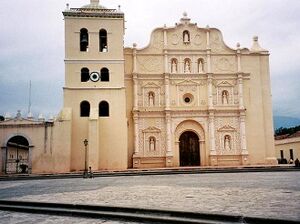
The most renowned Honduran painter is José Antonio Velásquez. Other important painters include Carlos Garay, and Roque Zelaya. Some of Honduras's most notable writers are Lucila Gamero de Medina, Froylán Turcios, Ramón Amaya Amador and Juan Pablo Suazo Euceda, Marco Antonio Rosa,[61] Roberto Sosa, Eduardo Bähr, Amanda Castro, Javier Abril Espinoza, Teófilo Trejo, and Roberto Quesada.
The José Francisco Saybe theater in San Pedro Sula is home to the Círculo Teatral Sampedrano (Theatrical Circle of San Pedro Sula)
Honduras has experienced a boom from its film industry for the past two decades. Since the premiere of the movie "Anita la cazadora de insectos" in 2001, the level of Honduran productions has increased, many collaborating with countries such as Mexico, Colombia, and the U.S. The most well known Honduran films are "El Xendra", "Amor y Frijoles", and "Cafe con aroma a mi tierra".
المطبخ
Honduran cuisine is a fusion of indigenous Lenca cuisine, Spanish cuisine, Caribbean cuisine and African cuisine. There are also dishes from the Garifuna people. Coconut and coconut milk are featured in both sweet and savory dishes. Regional specialties include fried fish, tamales, carne asada and baleadas.
Other popular dishes include: meat roasted with chismol and carne asada, chicken with rice and corn, and fried fish with pickled onions and jalapeños. Some of the ways seafood and some meats are prepared in coastal areas and in the Bay Islands involve coconut milk.
The soups Hondurans enjoy include bean soup, mondongo soup (tripe soup), seafood soups and beef soups. Generally these soups are served mixed with plantains, yuca, and cabbage, and served with corn tortillas.
Other typical dishes are the montucas or corn tamales, stuffed tortillas, and tamales wrapped in plantain leaves. Honduran typical dishes also include an abundant selection of tropical fruits such as papaya, pineapple, plum, sapote, passion fruit and bananas which are prepared in many ways while they are still green.
الإعلام
At least half of Honduran households have at least one television. Public television has a far smaller role than in most other countries. Honduras's main newspapers are La Prensa, El Heraldo, La Tribuna and Diario Tiempo. The official newspaper is La Gaceta (Honduras).
Music
Punta is the main music of Honduras, with other sounds such as Caribbean salsa, merengue, reggae, and reggaeton all widely heard, especially in the north, and Mexican rancheras heard in the rural interior of the country. The most well known musicians are Guillermo Anderson and Polache. Banda Blanca is a widely known music group in both Honduras and internationally.
Celebrations
Some of Honduras's national holidays include Honduras Independence Day on 15 September and Children's Day or Día del Niño, which is celebrated in homes, schools and churches on 10 September; on this day, children receive presents and have parties similar to Christmas or birthday celebrations. Some neighborhoods have piñatas on the street. Other holidays are Easter, Maundy Thursday, Good Friday, Day of the Soldier (3 October to celebrate the birth of Francisco Morazán), Christmas, El Dia de Lempira on 20 July,[62] and New Year's Eve.
Honduras Independence Day festivities start early in the morning with marching bands. Each band wears different colors and features cheerleaders. Fiesta Catracha takes place this same day: typical Honduran foods such as beans, tamales, baleadas, cassava with chicharrón, and tortillas are offered.
On Christmas Eve people reunite with their families and close friends to have dinner, then give out presents at midnight. In some cities fireworks are seen and heard at midnight. On New Year's Eve there is food and "cohetes", fireworks and festivities. Birthdays are also great events, and include piñatas filled with candies and surprises for the children.
La Ceiba Carnival is celebrated in La Ceiba, a city located in the north coast, in the second half of May to celebrate the day of the city's patron saint Saint Isidore. People from all over the world come for one week of festivities. Every night there is a little carnaval (carnavalito) in a neighborhood. On Saturday there is a big parade with floats and displays with people from many countries. This celebration is also accompanied by the Milk Fair, where many Hondurans come to show off their farm products and animals.
الرموز الوطنية

The flag of Honduras is composed of three equal horizontal stripes. The blue upper and lower stripes represent the Pacific Ocean and the Caribbean Sea. The central stripe is white. It contains five blue stars representing the five states of the Central American Union. The middle star represents Honduras, located in the center of the Central American Union.
The coat of arms was established in 1945. It is an equilateral triangle, at the base is a volcano between three castles, over which is a rainbow and the sun shining. The triangle is placed on an area that symbolizes being bathed by both seas. Around all of this an oval containing in golden lettering: "Republic of Honduras, Free, Sovereign and Independent".
The "National Anthem of Honduras" is a result of a contest carried out in 1914 during the presidency of Manuel Bonilla. In the end, it was the poet Augusto Coello that ended up writing the anthem, with German-born Honduran composer Carlos Hartling writing the music. The anthem was officially adopted on 15 November 1915, during the presidency of Alberto de Jesús Membreño.
The national flower is the famous orchid, Rhyncholaelia digbyana (formerly known as Brassavola digbyana), which replaced the rose in 1969. The change of the national flower was carried out during the administration of general Oswaldo López Arellano, thinking that Brassavola digbyana "is an indigenous plant of Honduras; having this flower exceptional characteristics of beauty, vigor and distinction", as the decree dictates it.
The national tree of Honduras was declared in 1928 to be simply "the Pine that appears symbolically in our Coat of Arms" (el Pino que figura simbólicamente en nuestro Escudo),[63] even though pines comprise a genus and not a species, and even though legally there's no specification as for what kind of pine should appear in the coat of arms either. Because of its commonality in the country, the Pinus oocarpa species has become since then the species most strongly associated as the national tree, but legally it is not so. Another species associated as the national tree is the Pinus caribaea.
The national mammal is the white-tailed deer (Odocoileus virginianus), which was adopted as a measure to avoid excessive depredation.[مطلوب توضيح] It is one of two species of deer that live in Honduras. The national bird of Honduras is the scarlet macaw (Ara macao). This bird was much valued by the pre-Columbian civilizations of Honduras.
الفولكلور
Legends and fairy tales are paramount in Honduran culture. Lluvia de Peces (Rain of Fish) is an example of this. The legends of El Cadejo and La Llorona are also popular.
الرياضة
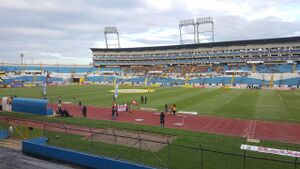
Football is the most popular sport in Honduras.[64] Honduras's first international competition began in 1921 at the Independence Centenary Games featuring neighboring countries in Central America.[65] The highest division of football is The Honduran National Professional Football League (Spanish: La Liga Nacional de Fútbol Profesional de Honduras), which was established in 1964.[66] The league is recognized on a continental level, as C.D. Olimpia–the only Honduran club to win the competition–won the CONCACAF Champions League in 1972 and 1988.[67][68] The Honduras national football team (Spanish: Selección de fútbol de Honduras) is considered one of the best nations in North America, as the country last won the CONCACAF Gold Cup in 1981 and placed third in 2013.[69][70] On a global scale, Honduras has competed in the FIFA World Cup three times in 1982, 2010, and 2014, although Los Catrachos have yet to win a game.[71][72][73]
Baseball is the second most popular sport in Honduras.[74] Honduras's first international competition began in 1950 in the Baseball World Cup, which was the most prestigious global competition at the time.[75] The country lacks a division in baseball, likely due to the absence of competition in international baseball since 1973.[بحاجة لمصدر] The Honduras national baseball team (Spanish: Selección de béisbol de Honduras) is shy of being a top ten nation in North and South America due to infrequent scheduling, although competition is consistent and growing at the youth level.[76][77] Inspiration at the youth level came from Mauricio Dubón being the first born and raised Honduran to start in Major League Baseball, who is currently competing today.[78]
All other sports tend to be minor at best, as Honduras has not won a medal in the Olympics and has not made notable results in other world championships yet.[79] However, Hondurans have consistently entered track & field and swimming games at the Summer Olympics since 1968 and 1984, respectively.[80] Occasionally, Honduras has competed in combat sports ranging from judo to boxing at the Summer Olympics as well.[81][82] Gender inequality in Honduras is present in the sports industry, as teams like the Honduras women's national football team (Spanish: Selección de fútbol de Honduras Femenina) has yet to qualify in global and continental tournaments and softball being nearly nonexistent in the country.[83][84]
انظر أيضاً
ملاحظات
الهامش
- ^ أ ب خطأ استشهاد: وسم
<ref>غير صحيح؛ لا نص تم توفيره للمراجع المسماةcia - ^ "Religion affiliation in Honduras as of 2020, by type". Statista. Archived from the original on 20 November 2022. Retrieved 18 November 2022.
- ^ قالب:Cite CIA World Factbook
- ^ أ ب ت ث "World Economic Outlook Database, October 2023 Edition. (Honduras)". IMF.org. International Monetary Fund. 10 October 2023. Archived from the original on 13 November 2023. Retrieved 15 October 2023.
- ^ "Gini Index coefficient". CIA World Factbook. Archived from the original on 17 July 2021. Retrieved 12 August 2021.
- ^ "Human Development Report 2021/2022" (PDF) (in الإنجليزية). United Nations Development Programme. 8 September 2022. Archived (PDF) from the original on 8 September 2022. Retrieved 12 October 2022.
- ^ Wells, John C. (2008), Longman Pronunciation Dictionary (3rd ed.), Longman, ISBN 9781405881180
- ^ "History of Honduras — Timeline". Office of the Honduras National Chamber of Tourism. Archived from the original on 28 May 2012. Retrieved 27 June 2010.
- ^ Davidson traces it to Herrera. Historia General de los Hechos de los Castellanos. Vol. VI. Buenos Aires: Editorial Guarania. 1945–1947. p. 24. ISBN 978-8474913323.
- ^ أ ب Davidson, William (2006). Honduras, An Atlas of Historical Maps. Managua: Fundacion UNO, Colección Cultural de Centro America Serie Historica, no. 18. p. 313. ISBN 978-99924-53-47-6.
- ^ Objetivos de desarrollo del milenio, Honduras 2010: tercer informe de país [Millennium Development Goals, Honduras 2010: Third Country Report] (PDF) (in الإسبانية). [Honduras]: Sistema de las Naciones Unidas en Honduras. 2010. ISBN 978-99926-760-7-3. Archived from the original (PDF) on 26 November 2021. Retrieved 9 February 2016.
- ^ Danny Law (15 June 2014), Language Contact, Inherited Similarity and Social Difference: The story of linguistic interaction in the Maya lowlands, John Benjamins Publishing Company, p. 105
- ^ Boyd Dixon (1989). "A Preliminary Settlement Pattern Study of a Prehistoric Cultural Corridor: The Comayagua Valley, Honduras". Journal of Field Archaeology. 16 (3): 257–271. doi:10.2307/529833. JSTOR 529833.
- ^ Susan Toby Evans; David L. Webster (11 September 2013). Archaeology of Ancient Mexico and Central America: An Encyclopedia. Routledge. ISBN 978-1136801860. Archived from the original on 21 March 2023. Retrieved 14 July 2016 – via Google Books.
- ^ "Columbus and the History of Honduras". Office of the Honduras National Chamber of Tourism. Archived from the original on 23 July 2010. Retrieved 27 June 2010.
- ^ Perramon, Francesc Ligorred (1986). "Los primeros contactos lingüísticos de los españoles en Yucatán". In Miguel Rivera; Andrés Ciudad (eds.). Los mayas de los tiempos tardíos (PDF) (in الإسبانية). Madrid, Spain: Sociedad Española de Estudios Mayas. p. 242. ISBN 9788439871200. OCLC 16268597. Archived (PDF) from the original on 12 April 2019. Retrieved 23 June 2020.
- ^ أ ب Clendinnen, Inga (2003) [1988]. Ambivalent Conquests: Maya and Spaniard in Yucatan, 1517–1570 (2nd ed.). Cambridge, UK: Cambridge University Press. pp. 3–4. ISBN 0-521-52731-7. OCLC 50868309.
- ^ Sharer, Robert J.; Loa P. Traxler (2006). The Ancient Maya (6th ed.). Stanford, California, US: Stanford University Press. p. 758. ISBN 0-8047-4817-9. OCLC 57577446.
- ^ Vera, Robustiano, ed. (1899). Apuntes para la Historia de Honduras [Notes on the History of Honduras] (in الإسبانية). Santiago: Santiago de Chile : Imp. de "El Correo,". Retrieved 9 February 2016.
- ^ Kilgore, Cindy; Moore, Alan (27 May 2014). Adventure Guide to Copan & Western Honduras. Hunter publishing. ISBN 9781588439222. Archived from the original on 21 March 2023. Retrieved 29 January 2011.
Spanish conquistadores did not become interested in colonization of Honduras until the 1520s when Cristobal de Olid the first European colony in Triunfo de la Cruz in 1524. A previous expedition headed by Gil Gonzalez Davila ...
- ^ Newson, Linda (October 1982). "Labour in the Colonial Mining Industry of Honduras". The Americas. 39 (2): 185–203. doi:10.2307/981334. JSTOR 981334.
- ^ Newson, Linda (December 1987). The Cost of Conquest: Indian Decline in Honduras Under Spanish Rule: Dellplain Latin American Studies, No. 20. Boulder: Westview Press. ISBN 978-0813372730.
- ^ United States. Department of State. Bureau of Public Affairs. Office of Public, Communication. (May 1992). "Honduras". Department of State Publication. Background Notes Series: 1–5. PMID 12178036. Archived from the original on 3 February 2022. Retrieved 2 December 2021.
- ^ "Honduras (05/03)". U.S. Department of State. Archived from the original on 3 February 2022. Retrieved 2 December 2021.
- ^ Becker, Marc (2011). "History of U.S. Interventions in Latin America". Marc Becker. Archived from the original on 7 November 2019. Retrieved 9 February 2016.
- ^ Economist explains (21 November 2013). "Where did banana republics get their name?". The Economist. Archived from the original on 14 November 2020. Retrieved 16 February 2016.
- ^ Malcolm D. MacLean (Summer 1968). "O. Henry in Honduras". American Literary Realism, 1870–1910. 1 (3): 36–46. JSTOR 27747601.
- ^ Graham, David A. (10 January 2013). "Is the U.S. on the Verge of Becoming a Banana Republic?". The Atlantic. Archived from the original on 8 March 2021. Retrieved 10 January 2018.
- ^ O. Henry (1904). Cabbages and Kings. New York City: Doubleday, Page & Company. pp. 132, 296.
banana republic Anchuria.
- ^ Eschner, Kat (18 January 2017). "SMARTNEWS Keeping you current Where We Got the Term "Banana Republic" Hint: it's not a great moment in American history". Smithsonian. Archived from the original on 2 January 2018. Retrieved 10 January 2018.
- ^ Where did banana republics get their name? Archived 14 نوفمبر 2020 at the Wayback Machine, The Economist
- ^ Chambers, Glen (24 May 2010). Race Nation and West Indian Immigration to Honduras, 1890–1940. Baton Rouge: Louisiana State University Press. ISBN 978-0807135570.
- ^ "USGS Hurricane Mitch". Archived from the original on 16 March 2006. Retrieved 5 April 2007.
- ^ "Honduras Becomes U.S. Military Foothold for Central America". NACLA. 4 September 2007. Archived from the original on 13 November 2018. Retrieved 13 November 2018.
- ^ "Honduran Congress Approves Withdrawal From ALBA". Americas Quarterly. 14 January 2010. Archived from the original on 23 June 2021. Retrieved 14 July 2021.
- ^ "OAS Suspends Membership Of Honduras" (Press release). Organization of American States. 5 July 2009. Archived from the original on 28 January 2016. Retrieved 9 February 2016.
- ^ "New Honduran leader sets curfew". BBC News. 29 June 2009. Archived from the original on 22 July 2010. Retrieved 27 June 2010.
- ^ أ ب "General Assembly condemns coup in Honduras" (Press release). United Nations. 30 June 2009. Archived from the original on 2 July 2017. Retrieved 9 February 2016.
- ^ Shankman, Sabrina (6 October 2009). "De Facto government in Honduras pays Washington lobbyists $300,000 to sway U.S. opinion". Gov Monitor. Archived from the original on 5 February 2010. Retrieved 30 July 2011.
- ^ "US Congress report argues Zelaya's ousting was "legal and constitutional"". MercoPress. 25 September 2009. Archived from the original on 5 April 2016. Retrieved 9 February 2016.
- ^ "Report by the Truth and Reconciliation Commission of Honduras" (PDF). Seattle International Foundation. 18 July 2011. Archived from the original (PDF) on 12 March 2016. Retrieved 9 February 2016.
- ^ "Honduras Truth Commission rules Zelaya removal was coup". BBC News. 7 July 2011. Archived from the original on 8 July 2011. Retrieved 20 June 2018.
- ^ Zebley, Julia (18 July 2011). "Honduras truth commission says coup against Zelaya was unconstitutional". JURIST. Archived from the original on 2 February 2013. Retrieved 17 September 2013.
- ^ "Honduras elected its first female president, Xiomara Castro". NBC News (in الإنجليزية). 1 December 2021. Archived from the original on 18 June 2022. Retrieved 5 December 2021.
- ^ "Xiomara Castro: Honduras' first female president sworn in". BBC News. 27 January 2022. Archived from the original on 4 February 2022. Retrieved 4 February 2022.
- ^ "Juan Orlando Hernández: Honduran ex-leader extradited to US". BBC News. 21 April 2022. Archived from the original on 23 May 2022. Retrieved 23 May 2022.
- ^ أ ب "Central America and Caribbean :: HONDURAS". CIA The World Factbook. 5 November 2021. Archived from the original on 11 April 2021. Retrieved 24 January 2021.
- ^ أ ب "Ethnologue: Languages of Honduras, Seventeenth edition data M. Paul Lewis, Gary F. Simons, and Charles D. Fennig, Editors" (PDF). Archived (PDF) from the original on 10 October 2022. Retrieved 8 November 2016.
- ^ "Honduras: Departments". citypopulation.de. Archived from the original on 9 May 2021. Retrieved 14 July 2021.
- ^ Annuario Pontificio. Cardinal Secretary of State. 2009. ISBN 978-88209-81914.
- ^ Bunson, Matthew E.; Min, D. (4 November 2015). Catholic Almanac. Huntington, Ind.: Sunday Visitor Publishing. pp. 312–13. ISBN 978-1612789446.
- ^ Dart, John (16 June 2009). "How many in mainline Categories vary in surveys". The Christian Century. 126 (12): 13. Archived from the original on 18 June 2016. Retrieved 9 February 2016.
- ^ Associated Press, 13 June 2009, reported in several papers
- ^ Scalon, Maria Celi; Greeley, Andrew (18 August 2003). "Catholics and Protestants in Brazil". America. 189 (4): 14. Archived from the original on 5 March 2012. Retrieved 17 September 2013.
- ^ "International Religious Freedom Report 2008: Honduras". U.S. Department of State. 19 September 2008. Archived from the original on 15 April 2016. Retrieved 9 February 2016.
- ^ Hansen-Nord, Nete Sloth; Skar, Mette; Kjaerulf, Finn; Almendarez, Juan; Bähr, Sergio; Sosa, Óscar; Castro, Julio; Andersen, Anne-Marie Nybo; Modvig, Jens (2014). "Social capital and violence in poor urban areas of Honduras". Aggression and Violent Behavior. 19 (6): 643–648. doi:10.1016/j.avb.2014.09.013.
- ^ أ ب ت ث "Honduras Travel Warning". Travel.State.Gov. U.S. State Department. Archived from the original on 17 August 2016. Retrieved 17 August 2016.
- ^ "InSight Crime's 2017 Homicide Round-Up". InSight Crime (in الإنجليزية الأمريكية). 19 January 2018. Archived from the original on 14 June 2018. Retrieved 3 July 2018.
- ^ "Why is Honduras so violent". Insight Crime. October 2015. Archived from the original on 13 November 2017. Retrieved 8 March 2020.
- ^ Varela, Amarela (November 2015). ""Buscando una vida vivible": la migración forzada de niños de Centroamérica como práctica de fuga de la "muerte en vida"". El Cotidiano (in Spanish). 30 (194): 19–29. قالب:ProQuest.
{{cite journal}}: CS1 maint: unrecognized language (link) - ^ Verity Smith (2014). Concise Encyclopedia of Latin American Literature. Routledge. p. 311. ISBN 978-1135960339. Retrieved 13 July 2016 – via Google Books.
- ^ "Honduras This Week Online June 1999". Marrder.com. 9 December 1991. Archived from the original on 17 January 2011. Retrieved 27 June 2010.
- ^ Acuerdo No. 429, 14 de mayo de 1928.
- ^ "Sports in Latin America and for U.S. Latinos!". University of Michigan. Archived from the original on 7 February 2023. Retrieved 15 December 2021.
- ^ "Central American Independence Centenary Cup 1921". International Football Database. Archived from the original on 7 February 2023. Retrieved 15 December 2021.
- ^ "Liga Betrics de Honduras". National Autonomous Federation of Football of Honduras. Archived from the original on 23 January 2023. Retrieved 15 December 2021.
- ^ "1971 CONCACAF Champions Cup". Rec.Sport.Soccer Statistics Foundation. Archived from the original on 7 February 2023. Retrieved 15 December 2021.
- ^ "1988 CONCACAF Champions Cup". The Rec.Sport.Soccer Statistics Foundation. Archived from the original on 16 November 2022. Retrieved 15 December 2021.
- ^ "CONCACAF Nations Cup 1981". Rec.Sport.Soccer Statistics Foundation. Archived from the original on 2 December 2022. Retrieved 15 December 2021.
- ^ "2013 CONCACAF Gold Cup". Major League Soccer. Archived from the original on 7 February 2023. Retrieved 15 December 2021.
- ^ "2010 FIFA World Cup". FIFA. Archived from the original on 10 September 2022. Retrieved 15 December 2021.
- ^ "1982 FIFA World Cup". FIFA. Archived from the original on 15 April 2022. Retrieved 15 December 2021.
- ^ "2014 FIFA World Cup". FIFA. Archived from the original on 27 September 2021. Retrieved 15 December 2021.
- ^ "Honduras – Hispanic Heritage Month". Major League Baseball Players Association. Archived from the original on 7 February 2023. Retrieved 15 December 2021.
- ^ "1950 Baseball World Cup". Web Archive. Archived from the original on 25 September 2018. Retrieved 15 December 2021.
- ^ "WBSC Rankings – Americas". World Baseball Softball Confederation. Archived from the original on 15 December 2021. Retrieved 15 December 2021.
- ^ "WBSC Rankings – Honduras". World Baseball Softball Confederation. Archived from the original on 15 December 2021. Retrieved 15 December 2021.
- ^ "Mauricio Dubon's high school baseball & soccer career made for MLB". NBC. 4 May 2020. Archived from the original on 15 December 2021. Retrieved 15 December 2021.
- ^ "Honduras – IOC Profile". International Olympic Committee. Archived from the original on 15 December 2021. Retrieved 15 December 2021.
- ^ "Olympedia – Honduras". Olympedia. Archived from the original on 15 December 2021. Retrieved 15 December 2021.
- ^ "Honduras in Judo at the Olympics". Olympedia. Archived from the original on 15 December 2021. Retrieved 15 December 2021.
- ^ "Honduras in Boxing at the Olympics". Olympedia. Archived from the original on 15 December 2021. Retrieved 15 December 2021.
- ^ "WBSC Rankings – Americas". World Baseball Softball Confederation. Archived from the original on 15 December 2021. Retrieved 15 December 2021.
- ^ "Honduras FIFA Profile". FIFA. Archived from the original on 15 December 2021. Retrieved 15 December 2021.
المصادر
- Adventures in Nature: Honduras; James D. Gollin
- Don't Be Afraid, Gringo: A Honduran Woman Speaks From The Heart: The Story of Elvia Alvarado; Medea Benjamin
- Honduras: The Making of a Banana Republic; Alison Acker
- Honduras: State for Sale; Richard Lapper, James Painter
- Inside Honduras; Kent Norsworthy and Tom Berry
- La Mosquitia: A Guide to the Savannas, Rain Forest and Turtle Hunters; Derek Parent
- Moon Handbooks: Honduras; Christopher Humphrey
- Reinterpreting the Banana Republic: Region and State in Honduras, 1870-1972; Dario A. Euraque
- Seven Names for the Bellbird: Conservation Geography in Honduras; Mark Bonta
- Ulysses Travel Guide: Honduras; Eric Ilamovitch
- The United States in Honduras, 1980-1981: An Ambassador's Memoir; Jack R. Binns
- The War of the Dispossessed: Honduras and El Salvador, 1969; Thomas P. Anderson
وصلات خارجية
- Official Website
- Government of Honduras (بالإسپانية)
- Official Site of the Tourism Institute of Honduras (English)
- Honduras at University of Colorado at Boulder Libraries GovPubs
- هندوراس at the Open Directory Project
 Wikimedia Atlas of Honduras
Wikimedia Atlas of Honduras- هندوراس travel guide from Wikitravel
- Wikia has a wiki on this subject: Honduras
- Honduras Tips Travel Info (English)
- Travel and Tourism Info on Honduras (English)
- Humanitarian Aid in Honduras
- Honduran English Language weekly newspaper
- Answers.com
- Articles containing إسپانية-language text
- CS1 الإسبانية-language sources (es)
- CS1 الإنجليزية الأمريكية-language sources (en-us)
- Short description is different from Wikidata
- Articles with hatnote templates targeting a nonexistent page
- جميع المقالات الحاوية على عبارات مبهمة
- جميع المقالات الحاوية على عبارات مبهمة from December 2017
- جميع الصفحات التي تحتاج تنظيف
- مقالات بالمعرفة تحتاج توضيح from July 2016
- Articles with unsourced statements from June 2022
- مستعمرات إسپانية سابقة
- هندوراس
- بلدان ناطقة بالاسبانية
- دول وأراضي تأسست في 1821
- Countries in Central America
- Former Spanish colonies
- Member states of the United Nations
- جمهوريات
- Spanish-speaking countries and territories
- States and territories established in 1821
- 1821 establishments in North America
- Countries in North America
- Northern Triangle of Central America
- بلدان أمريكا الشمالية



